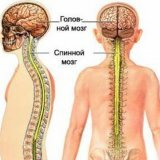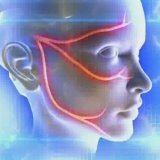Acute disseminated encephalomyelitis (AEM): what is it, symptoms, treatment
Content
- What is acute disseminated encephalomyelitis?
- Affected populations
- Causes of acute disseminated encephalomyelitis
- Signs and symptoms of WECM
- Diagnostics of the wholesale electricity market
- Treatment of acute disseminated encephalomyelitis
- Forecast at wholesale electricity market
What is acute disseminated encephalomyelitis?
Acute disseminated encephalomyelitis (abbr. OREM) is a disease of the central nervous system, characterized by a short but widespread attack of inflammation in the brain and spinal cord, which damages myelin - protective covering of nerve fibers.
WECM often follows viral or bacterial infections or, less commonly, vaccination against measles, mumps or rubella. WECM symptoms appear quickly, beginning with encephalitis-like symptoms such as fever, fatigue, headache, nausea and vomiting, and in the most severe cases, seizures and coma.
Acute disseminated encephalomyelitis usually damages white matter (brain tissue that takes its name from white myelin), resulting in neurological symptoms
such as loss of vision (due to inflammation of the optic nerve) in one or both eyes, weakness even to the point paralysis and difficulty in coordinating voluntary muscle movements (for example, those used for walking).WECM is sometimes misdiagnosed as a severe first attack multiple sclerosis (abbr. MS), as the symptoms and appearance of white matter damage on imaging of the brain can be similar. Nevertheless, the WECM has several features that distinguish it from multiple sclerosis. First, unlike patients with MS, people with AREM will have a rapid (acute) onset of fever, a history of recent infection or immunization, and some degree of impaired consciousness, possibly even a coma; these features are usually not seen in MS. Children are more likely than adults to suffer from WECM, while MS is rarely diagnosed in children. In addition, WECM usually consists of a single episode or attack with widespread myelin damage, while MS has many attacks over time.
Doctors will often use imaging techniques such as MRI (magnetic resonance imaging) to look for old and new lesions (areas of damage) in the brain. The presence of older brain lesions on MRI suggests that it may be MS, rather than a WECM, as MS can cause brain damage before symptoms become obvious. In rare cases, a brain biopsy may be required to differentiate between WECM and certain other conditions that include inflammation and myelin damage.
Read also:Epilepsy
Affected populations
WECM can develop at any age, but it is much more common in children than in adults. Men and women are equally affected, although a slight predominance of men was noted in pairs of pediatric studies. In children, the disease is diagnosed on average at the age of 5-8 years. The exact frequency of occurrence of the wholesale electricity market among the population of Russia as a whole is unknown. The disease appears to peak during the winter and spring months in studies in the United States.
Causes of acute disseminated encephalomyelitis

The exact cause of acute disseminated encephalomyelitis is not known. However, most clinical researchers agree that the disorder is most likely the result an abnormal reaction of the immune system to an infection or other trigger. Many researchers suggest that WECM may represent an abnormal immune response directed against the body's own tissues (autoimmune disorder). In autoimmune disorders, the body's natural defenses (e.g. antibodies, lymphocytes) against substances which are perceived as foreign (antigens), inappropriately begins to attack healthy tissues by unknown reasons.
OREM often develops after upper respiratory tract infections, usually of a viral cause. Specific agents that have been identified as causing the disease include:
- flu;
- measles;
- parotitis;
- rubella ;;
- chickenpox;
- Epstein-Barr virus;
- cytomegalovirus infection;
- herpes simplex virus.
Some bacterial agents can also cause WECM.
Less commonly, acute disseminated encephalomyelitis may develop after vaccination. Certain vaccinations against rabies have been associated with the development of the disorder. Other vaccinations that are thought to lead to WECM include smallpox and some measles vaccinations at an older age. In rare cases, vaccinations against whooping cough and influenza have been associated with WECM. In very rare cases, the disease has occurred after an organ transplant. The risk of developing a wholesale electricity market is extremely low and should not exclude routine vaccinations in accordance with the recommendations.
Many factors in addition to immunological factors may also play a role in the development of WECM, possibly including genetic and environmental factors.
Signs and symptoms of WECM

The progression and severity of the WECM varies from one person to another. Some people may have mild, self-limited forms of the disorder; others may develop more severe symptoms, and in the most severe cases, life-threatening complications such as respiratory failure may occur.
Initial symptoms They usually develop rapidly and may include a variety of symptoms common to many different diseases (non-specific symptoms), including:
- fever;
- headaches;
- irritability;
- fatigue;
- lethargy;
- general ill health (malaise);
- unintentional weight loss;
- stomach ache;
- loss of appetite;
- nausea and vomiting.
Read also:Niemann-Pick disease
In some cases, these symptoms may be accompanied by changes in mental status, such as:
- confusion of consciousness;
- stupor;
- rave;
- and possibly a coma.
In some cases, additional neurological symptoms may develop. Specific symptoms vary from one person to another depending on the exact location of the lesions in the central nervous system. It is important to note that affected individuals may not have all of the symptoms described below. Affected people should talk to their doctor about their specific case, associated symptoms, and overall prognosis.
Neurological symptomsthat can potentially develop in acute disseminated encephalomyelitis include:
- inability to coordinate voluntary movements (ataxia);
- paralysis of one side of the body (hemiplegia);
- myoclonus;
- convulsions;
- slurred speech;
- cranial nerve palsy;
- numbness on one side of the body.
In rare cases, inflammation of the optic nerve (optic neuritis) can develop, which can lead to loss of vision. Adults with AREM have also had a disease affecting nerves outside the central nervous system (peripheral nervous system disorders), which is very rare in children. Peripheral nervous system disorders can cause weakness, pain, numbness, or burning or tingling in the extremities. In some cases, additional symptoms may develop, including:
- involuntary movements;
- amnesia;
- personality changes;
- depression.
The symptoms of acute disseminated encephalomyelitis may also depend on the age of onset. Seizures are common in children and adults. Prolonged fevers and headaches are more common in children than in adults. Sensory deficits predominantly affect adults.
Diagnostics of the wholesale electricity market
The diagnosis of WECM is based on the identification of characteristic symptoms, a detailed medical history, and a thorough clinical evaluations and various specialized tests, including imaging techniques such as magnetic resonance imaging (MRI). MRI uses a magnetic field and radio waves to produce cross-sectional views of selected organs and tissues organism and may demonstrate characteristic brain lesions in people with this disease. Additional studies to rule out other conditions may also be performed. Such studies may include infectious, immunological and metabolic studies.
Treatment of acute disseminated encephalomyelitis

There is no standard therapy for OREM. Most of the treatments that have been used to treat acute disseminated encephalomyelitis have some effect of suppressing the activity of the immune system (immunosuppressive therapy). Such treatments include the use of:
- corticosteroid medications;
- intravenous immunoglobulin therapy;
- plasmapheresis (a procedure for taking blood, cleaning it and returning it back to the bloodstream).
Read also:Cerebral aneurysm (cerebral aneurysm)
For the treatment of people with AREM, they are usually used high doses of corticosteroids and this is usually considered the mainstay of therapy. Corticosteroids have been shown to improve symptoms in many cases. Methylprednisolone is the most commonly used corticosteroid drug for treating people with AREM.
However, there are significant differences in the specific forms, routes of administration, dosage and tapering schedule in the treatment of patients with corticosteroids. In addition, high doses of corticosteroids can cause significant side effects in some patients.
Intravenous immunoglobuin therapy is used to treat certain individuals with AREM who are unresponsive or cannot tolerate corticosteroid therapy. Intravenous immunoglobuin is a concentrated solution of antibodies extracted from the blood of healthy donors. This therapy is used to treat various autoimmune diseasesbecause it can neutralize the action of autoantibodies, which are antibodies that mistakenly attack healthy tissue.
Plasmapheresis has also been used to treat people not responding to other forms of therapy. However, its use has only been described in a few specific cases. Plasmapheresis is a procedure, a method of removing unwanted substances (toxins, metabolic substances and parts of plasma) from the blood. The blood is removed from the patient and the blood cells are separated from the plasma. The patient's plasma is then replaced with another person's plasma and the blood is returned to the patient.
Forecast at wholesale electricity market
Corticosteroid therapy usually helps speed recovery from most symptoms of acute disseminated encephalomyelitis. The long-term prognosis for people with WECM is generally favorable. For most people, recovery begins within a few days, and within six months, most patients with AREM will have a complete or near complete recovery. Others may have mild to moderate life-long impairments, ranging from cognitive problems, weakness, vision loss, or numbness.
Severe cases of acute disseminated encephalomyelitis can be fatal, but this is very rare. AREM can recur, usually within a few months after the initial diagnosis, and is treated by restarting corticosteroid therapy. A small proportion of people who have been diagnosed with AREM may subsequently develop multiple sclerosis, but in there is currently no method or known risk factors to predict which patients she is will affect.



